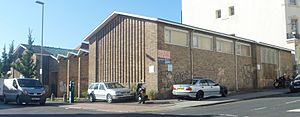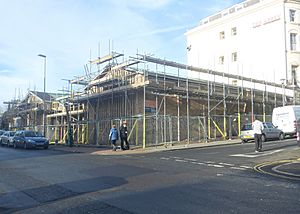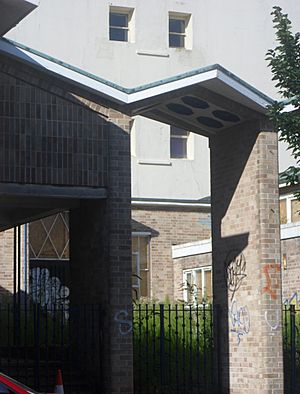Montpelier Place Baptist Church, Brighton facts for kids
Quick facts for kids Montpelier Place Baptist Church |
|
|---|---|

The church from the southeast in August 2017, just before demolition started
|
|
| 50°49′37″N 0°09′15″W / 50.8269°N 0.1541°W | |
| Location | Montpelier Place, Montpelier, Brighton BN1 3BF |
| Country | United Kingdom |
| Denomination | Baptist |
| Churchmanship | Strict Baptists |
| History | |
| Former name(s) | Baptist Tabernacle |
| Status | Church |
| Founded | 4 April 1834 (at West Street) |
| Events | 1 April 1967: present church opened 15 May 1967: present church registered 12 December 2014: registration cancelled December 2017: demolition commenced |
| Architecture | |
| Functional status | Demolished |
| Architect(s) | E. Joseph Wood |
| Architectural type | Church |
| Style | Modernist |
| Years built | 1965–66 |
| Completed | 1966 |
| Closed | 2012 |
| Demolished | 2018 |
The Montpelier Place Baptist Church was a church building in Brighton, England. It was also known as the Baptist Tabernacle. This church opened in 1967. It replaced an older church that had been in use for 140 years.
The church was located in the Montpelier area of Brighton. It closed in 2012 and was taken down between 2017 and 2018. Now, new houses and flats stand on the site. This new building project finished in December 2019.
The original church on West Street started for a group of Christians called Independent Calvinists. Later, their beliefs changed to Strict Baptist. The new church in Montpelier Place kept this Strict Baptist style. In its last years, it was part of a group of Reformed Evangelical Christian churches. The church became less popular in the 2000s, which led to its closing. For a while, the empty building was used by people without permission. The Montpelier Place church had a very modern look, different from the older, classical-style church it replaced.
Contents
History of the Church
The First Church on West Street
In the 17th century, many Protestant groups in East Sussex were not part of the main Church of England. These groups were called Nonconformists. A specific type of Christian belief, called Calvinism, was very important in this area.
In Brighton, many Strict Baptist and independent Calvinist churches were started in the 1700s and 1800s. These churches often came from two older ones: Salem Chapel (from 1766) and Providence Chapel (from 1805).
The Tabernacle on West Street was one of the later churches. It opened in 1834. Some people say it was started by members who left Providence Chapel. Another story says a visiting preacher from London was so well-liked at Salem Chapel in 1833 that people asked him to stay. He began preaching in rented rooms in January 1834. On April 16, 1834, the church officially began under his leadership.
A place for the new church was found near West Street. The first stone of the Tabernacle was laid on May 1, 1834. The building was finished four months later. It was registered for weddings in November 1837.
The church building looked like a Neoclassical style building. It had a triangular top part called a pediment. Its front was covered in a smooth material. A photo from the 1950s shows a tall, two-story front with three sections. It had arched windows and decorative columns called pilasters. The church could hold 900 people. Inside, there were balconies on three sides. The preacher's stand was on two levels.
Until 1865, the church's beliefs were different from Strict Baptist churches. Strict Baptists believed that only people who had been baptized could join the church and take part in communion. The Tabernacle, however, allowed "open communion," meaning anyone could participate.
In 1865, there was a disagreement about choosing a new pastor. This led some Strict Baptist members to leave. They started their own church, Galeed Chapel, in 1868. But in 1906, the Tabernacle itself became a Strict Baptist church after a new minister was chosen. It was common for churches to change their beliefs over time.
By the 1960s, the West Street church was too big for its small group of members. The city council planned to rebuild the area west of West Street. The church building was included in these plans. It was taken down in 1965. A new church hall for St Paul's Church was built on the site.
The New Church on Montpelier Place
At the same time, work began on a new church for the congregation. A spot became available in the Montpelier area, near the border with Hove. This site used to have another church, built in 1867. That building was cleared away in 1965. Later that year, E. Joseph Wood was hired to design the new Baptist church. A stone from the old West Street chapel was placed in one of the new church's outside walls.
The new church was built across the old boundary line between Brighton and Hove. Construction finished, and the church opened on April 1, 1967. It was officially registered for Strict Baptist worship on May 15, 1967. It was also allowed to hold weddings on the same day. Later, the church joined GraceNet UK, a group of Reformed Evangelical Christian churches.
In the 2000s, the Montpelier Place Baptist Church began to decline. Another similar church in Brighton was rebuilt with flats above it. There was no longer a need for two such churches in the city. Montpelier Place Baptist Church closed in 2012. It stood empty until early 2014, when people started living in it without permission. Its registration for weddings was officially cancelled in December 2014.
A local Islamic group thought about buying the site for a new mosque. But in 2017, the Grace Baptist Trust sold the empty church building to developers for £3 million. A local company made plans for new homes on the site. These plans included five townhouses, 19 flats, and one building for shops or community use. Permission for this was given in October 2017. The church was taken down soon after and was completely gone by early 2018. The new homes were finished in December 2019.
Church Design
The Montpelier area of Brighton mostly has similar-looking buildings. Most were built in the 1840s and 1850s. They are in the Regency or post-Regency style, with some Italian and early Victorian touches. There are not many modern buildings in the area. So, Montpelier Place Baptist Church stood out.
The church was described as "not without merit" in its design. However, it was thought to be "too low and spreading" for an area with many tall 19th-century buildings. The main front of the church faced south. It had a wide section on the west and a narrower one on the east. Both sections had shallow pointed roofs called gables.
Between these sections was an arcade. This was made of narrow, vertical brick slabs. On top, it had a "saw-tooth" roof that hung over, similar to Coventry Cathedral, which opened in 1961. Behind this arcade was a partly open space. The larger, western part of the building was the church itself. The eastern part was used as a hall. Both of the southern walls had a pattern of bricks that were set back into the wall.
Images for kids





